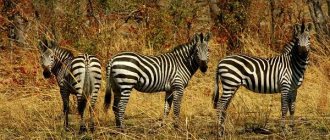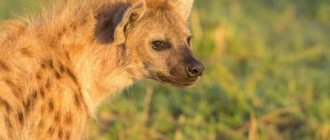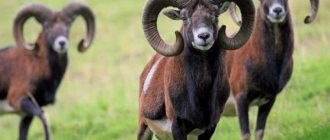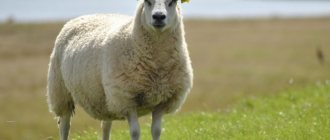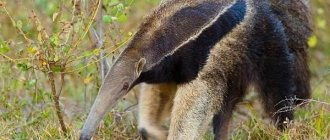Zebra - African horse
Zebra - perhaps, along with the lion, elephant, giraffe and hippopotamus, is one of the symbols of the more than rich animal world of Africa. Therefore, it is not at all surprising that the name “zebra”, a word of African origin, came unchanged to all European languages. The zebra is an African relative of our horse, it belongs to the equine family, the order of equids, the class of mammals, and our article today is about it.
Description of zebra, structure, characteristics
The zebra's body is of medium size, usually about 2 meters in length, and the tail grows up to 50 cm. The average weight of zebras is approximately 300-350 kg. The male zebra is larger than the female. In general, the physique of zebras is very dense and stocky. The zebra's mane is stiff and short, and its neck is muscular, and in males it is more muscular than in females.
The zebra also has very strong hooves, which are often the key to its survival in the African shroud. Although zebras do not run as fast as horses, they are much more resilient, and when in danger (especially in the form of hungry lions, cheetahs, hyenas and other predators) they can reach speeds of up to 80 km per hour. Moreover, it is interesting that zebras often run away from their pursuers in zigzags, knocking down predators; this is their special tactic. Also, zebras sometimes use their powerful hooves as real weapons to fight off the same attacking lions.
But zebras, alas, cannot boast of their vision; it is poorly developed in them, but this deficiency is fully compensated by their excellent charm - by smell, a zebra can smell potential danger and warn its native herd about it. However, lions are also well aware of this feature of zebras, and therefore it is not without reason that they sneak up on a herd of grazing zebras from the windward side, so that it is more difficult for the zebras to smell them.
Where live
The habitat of zebras is limited exclusively to the African continent. They are distributed in the southern half, and the habitat of each species has its own specific boundaries. Thus, the desert zebra is found in eastern Africa, and the savanna zebra is found in the south and southeast of the continent.
Where do they live?
Almost any habitat is suitable for zebras to live: savannas, lowland and mountain forests, semi-deserts.
ANTELOPE
Zebra stripes. Why is a zebra striped?
Philosophers often compare our life with a zebra: the black stripe gives way to white, white to black, and so on ad infinitum, in such a way that the zebra itself, or rather its amazing color, has become a symbol of the impermanence of our existence. But these are philosophers, but scientific zoologists are engaged in other debates, more mundane, namely what color the zebra is: white with black stripes, or black with white stripes. Recently, scientists have argued that the dominant color of the zebra is still black. Also, these same stripes are unique for each zebra and create their own unique pattern, which, by the way, also serves for practical purposes; it is by this unique pattern that zebra cubs recognize their mother.
But this is not the only benefit of the zebra’s famous stripes; they also serve as a kind of camouflage - the animal visually merges with the hot, trembling air of the African shroud, which disorients predators. Also, striped camouflage perfectly protects against annoying flies and horseflies. The structure of the eyes of flies and horseflies is designed in such a way that they react only to polarized color, and the black and white zebra is simply perceived as an inedible object.
Zebra stripes also thermoregulate their body and help cool it. It works in this way: white stripes (like everything white) heat up much less than black stripes, the temperature difference creates microcirculation of air flows around the zebra, which allows it to endure the exhausting African heat much more easily.
Life in captivity
You can meet a zebra in many zoos. She is cared for in much the same way as ordinary horses. Her stall is protected from the weather, and regular horse food is provided as food. It is important that zebras should not be given any human food. Specifically bread, cereal, sugar and chips. This food provokes a number of diseases that lead to a shortening of their life. Zebras also have their hooves trimmed periodically, since in zoos they cannot grind them down on their own, which is why they may suffer from severe pain.
Types of zebras, names and photographs
Zebras are actually divided into three types, and below we will write about each of them.
Savannah zebra
She is also the brown zebra - the most common, conventionally “classic” species of zebra, living mainly in Southeast Africa. The “burchelovaya” zebra received its name in honor of the English zoologist William Burchell, who spent many years studying the lifestyle and habits of zebras. In particular, he noticed that the black and white patterns on the bodies of zebras differ depending on their habitats, for example, zebras living closer to the equator have a very pronounced pattern, while zebras living in southern Africa have a blurry pattern on the bottom. body, and the presence of beige stripes on a white background of the skin. Depending on the coloring, there were as many as 6 subspecies of the brown zebra.
desert zebra
She's Grevy's zebra. The name "Grevy" was given to the first president of France, Jules Grevy, to whom the authorities of Abyssinia presented a zebra of this species as a gift at the end of the 19th century. The desert zebra is the largest not only among zebras, but also among all other representatives of the horse family - its body length reaches up to 3 m, and its weight is over 400 kg. They are also distinguished by a predominance of white color and a wide black stripe running along the zebra’s back. The stripes of the desert zebra themselves are thinner than those of the savannah and are located closer to each other. They live in eastern Africa and can be found in the national parks of Kenya, Uganda, and Ethiopia.
Mountain zebra
It has the darkest color among other zebras and is in turn divided into two subspecies: the Cape mountain zebra and the Hartmann's mountain zebra.
The Cape mountain zebra lives in the territory of the Republic of South Africa and is under state protection; excessive extermination of zebras at the beginning of the last century led to the fact that the Cape mountain zebras were on the brink of extinction. But even today, despite protective measures, the number of these zebras is not very large; according to zoologists, only about 400 individuals of this zebra species live in the national parks of South Africa. And the Cape zebra is the smallest among all zebras. It also differs from other zebras in that it does not have stripes on its belly.
Hartmann's mountain zebra, like the Cape zebra, is also on the verge of extinction, which is, of course, due to human stupidity and greed - at the beginning of the last century, white farmers who settled in Africa mercilessly shot zebras that prevented them from walking their cattle. Hartmann's zebra is slightly larger than the Cape zebra and has narrower black stripes. Lives in the mountainous regions of Namibia (southwest Africa).
Zebroids and Zebrulas
Zebroids and zebras are hybrids born from crossing a zebra and a horse, as well as a zebra and a donkey. Usually a zebra is used as a male, and a horse as a female; the cubs born look more like a horse, but their color is striped - an inheritance from the zebra dad. Hybrids are similar to zebras, but are much better trained than zebras and are sometimes used as pack animals.
Habitat
The ancestors of modern zebras appeared in Africa about 2 million years ago, and successfully populated the entire Black Continent. But with the advent of man on the planet, who hunted herbivores, the habitat of these amazing creatures gradually decreased, and now their natural environment is limited to the southern and eastern parts of the continent.
Zebras were once found in every corner of Africa
Zebras are common in the following African countries:
- Namibia;
- SOUTH AFRICA;
- Sudan;
- Ethiopia;
- Kenya;
- Somalia;
- Angola;
- Uganda.
Zebras still live in the wild, but even in most of the above countries they live in nature reserves and national parks, and are protected at the state level. Local municipalities have created special units whose task is to protect animals from poachers and hunters from aboriginal tribes.
What does a zebra eat?
It's no secret that the zebra is a herbivore, loving lush grass, leaves of bushes, and plant roots. Zebras eat a lot and during dry seasons they migrate in whole herds in search of green pastures. Also, the body of a zebra (and especially a pregnant female) requires a lot of moisture and the presence of nearby water is a very important circumstance for the life of a zebra. If rivers or lakes dry up, and this happens under the scorching African sun, zebras can even dig a small artificial well themselves.
Nutrition
As a rule, the diet of zebras is determined by the territory of their habitat. Their diet may include various grasses, shrubs, shoots and their plants. Because of this low-calorie diet, they are forced to eat most of the time. Due to the simple structure of the stomach, they easily process fiber, obtaining sufficient amounts of protein and vitamins.
Water also plays an important role for the normal functioning of the zebra's body. They tolerate thirst very poorly and are forced to look for sources to drink at least once a day. Females that feed their cubs are more dependent on water. Most often, zebras go to water in areas with rivers and lakes. However, in harsh climates they often dry out. Therefore, many zebras independently dig deep holes in which rainwater accumulates or water penetrates to the surface from underground sources.
During periods of drought, zebras prefer to move to other places where they can get water and pasture with vegetation. Zebras sometimes travel very long distances in search of food and water.
Zebra lifestyle and reproduction
Zebras are herd animals, living in large herds under the leadership of an adult stallion. But the most important thing within a herd of zebras is not the “boss stallion,” but the eldest female, she is something like an elder. The main part of the herd consists of females with their cubs. It is interesting that male zebras, upon reaching sexual maturity (3 years), are expelled from the parental herd and can form their own “male” herd or live alone (which is much more dangerous).
About once every two to three years, female zebras become pregnant and give birth to cubs. The gestation period itself lasts about 370 days. During birth, the male father, like a true gentleman, protects the mother and cub.
Little zebra cubs develop very quickly, after just 10-15 minutes a newborn baby can already stand on his feet, after another five minutes he is already walking, and after an hour he can already stomp with his mother zebra for a decent distance.
Interesting fact: the mother zebra's milk, which she feeds her cubs, is of an unusual color - it is pink. It contains many useful nutrients necessary for the growing body of a baby zebra.
Pink zebra milk.
Lifestyle
All zebras are characterized by family packs led by an adult stallion. Most of this herd consists of a large number of females and small cubs. There is also an oldest mare in each pack. Males in packs are not protected, so at the age of 1 to 3 years they are forced to leave the herd and become outcasts.
Animals distinguish each other by patterns on their bodies, smell and voice. The main characteristic of zebras is sleeping while standing. In order to protect each other, all individuals of the flock gather together and sleep. In this way, they can protect themselves from attacks by other predators.
Zebras use barking and neighing to communicate with each other. Their mood can be determined by the position of their ears. In a calm state, the ears stand straight, and during periods of aggression they go back. An animal's fear can be identified by the position of its ears in front. Aggression may be shown through snorting or loud barking sounds.
What zebras can do
Interesting facts about zebras
- Zebras have a wild and evil disposition; in a moment of danger, a zebra driven into a corner can even fight back against a lion. Also, the violent and wild nature of these amazing representatives of the horse family led to the fact that man was never able (unlike an ordinary horse) to tame zebras.
- Zebras are one of the few animals along with humans that have color vision. The only thing is that they do not distinguish the color orange at all.
- Zebras can wallow in the mud for a long time, which, oddly enough, speaks of their... cleanliness. The fact is that in this simple way they get rid of annoying insects.
- Zebras cooperate well with other African herbivores: wildebeests and even giraffes, creating large communal herds in which it is much easier to protect themselves from predators.
